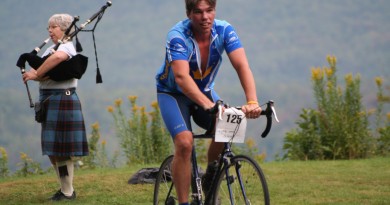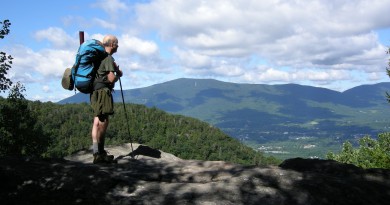Sports Medicine: Injury in the Older Runner
By Rob Rinaldi, DPM
Age not only slows down the cardiovascular system, resulting in a slower pace, but the added candle on our birthday cakes makes us more prone to injury.
Running puts a lot of stress on feet and legs. The average runner is increasing the gravitational forces on joints as much as 10 to 12 times. The slower runners have the highest levels of impact. Just walking will cause these levels to be close to double body weight. A 60-year-old athlete has put a lot of miles on the “old dogs,” just walking around, let alone training.
There are 26 bones and 33 joints in each foot that can show signs of age with arthritis and dysfunction. Joint stiffness is the number one complaint of the older runner, followed by muscle and tendon stiffness. Adipose (fat) tissues on the bottom of the feet normally atrophy with age, and this causes the weight-bearing bones to be exposed to increased punishment. This triad of joint stiffness, muscle/tendon stiffness and loss of fat pads is the prime cause of injury in the older runner. Plantar fasciitis leads the way as number one presenting diagnosis. Achilles tendonitis is not too far behind as a cause of sidelining the veteran. Tendonitis of the peroneals and the posterior tibial tendons are common injuries. Metatarsal head bursitis is common and very disabling.
Joint Stiffness
No remedy exists for arthritis. There is little real research into the benefit of taking glucosamine, but the general consensus is that it is helpful as it may provide some needed elasticity to the ligaments within each joint, and if true, this will be helpful in reducing stiffness associated with arthritis. I am a firm believer that just plain water is helpful as well. This subject is a complicated issue and may be an article all by itself, but older individuals fail to consume enough water. Water is essential for the function of muscles, tendons, and joints. Take glucosamine if you’d like, but begin to increase your water intake to at least 64 ounces per day as well.
Plantar Fasciitis
Most people hyperpronate, and this causes the plantar fascia to over stretch with each step. The result of this increased stress results in inflammation and reduced ability to work efficiently as a windlass mechanism (a controlled hitch or hoist) in the foot. After rest and a period of non-weight bearing, the plantar fascia contracts but then must stretch rapidly at first step. Because it is inflamed, this initial stretch is difficult and painful. Controlling hyperpronation, with appropriate shoes and intrinsically posted orthotics, is essential for the older athlete.
Achilles Tendonitis
There are many causes of A.T., but in the older athlete this often naturally follows chronic plantar fasciitis. Longer warm-up followed by easy stretching is helpful but controlling the hyperpronation remains an important key.
Peroneal and Posterior Tibal Tendonitis
These tendons and associated muscles course on either side of the ankle and help with ankle stability. The older athlete may be in good shape for moving forward, but when entropy sneaks up, these athletes lose the agility necessary to move over uneven surfaces. Often this results in peroneal tendonitis and even posterior tibial insufficiency. The key prevention is ankle agility exercise done several times per week.
Loss of Plantar Fat Pad
There is no way to prevent this from occurring with age, but running shoes can supplement the need without a problem. Keep your running shoes fresh. Never let more than 300 to 400 miles accumulate on a shoe. I have found that the older runner is often the more frugal runner but going “cheap” on the most important piece of equipment in your bag can cause injury and keep you sidelined.
I see many athletes well into their 70s. The best of them workout at least six days per week, pay attention to core strength with weight training, vary their workouts, and most important, they warm-up slowly, methodically, and for a long time. One vet told me that some days the warm-up was the workout. I will be 70 in April and I know what he means.
Robert Rinaldi is a board-certified podiatrist and podiatric surgeon on staff at the Gifford Medical Center in Randolph. He is a fellow and a founder of the American Academy of Podiatric Sports Medicine. He is a former nationally ranked long distance runner having completed 25 world-class marathons. You may reach him at Gifford Medical Center, (802) 763-8000 or at rrinaldi@giffordmed.org.



